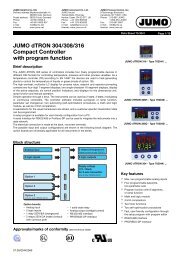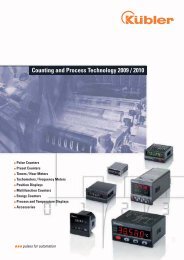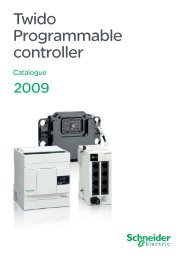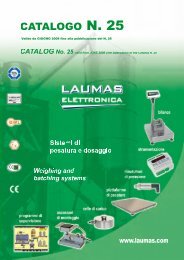Automation platform Modicon Premium
Automation platform Modicon Premium
Automation platform Modicon Premium
You also want an ePaper? Increase the reach of your titles
YUMPU automatically turns print PDFs into web optimized ePapers that Google loves.
Memory structure (continued)<br />
<strong>Modicon</strong> <strong>Premium</strong><br />
automation <strong>platform</strong><br />
Atrium slot PLCs<br />
Unity<br />
Slot PLC with data storage memory card in slot no. 0<br />
Located data<br />
Internal RAM<br />
Global and DFB<br />
unlocated data<br />
Program, symbols and<br />
area for online program<br />
modification<br />
Constants<br />
PCMCIA data<br />
storage card (slot<br />
no. 0)<br />
Storage of additional<br />
data<br />
160 or 208 Kb<br />
4096 or 8192 Kb<br />
1<br />
1<br />
2<br />
3<br />
4<br />
Memory structure (continued)<br />
Extension of the data storage area<br />
Memory cards reserved for data storage (4096 or 8192 Kb) are used to:<br />
b Access the data storage area when the application is entirely supported by the<br />
internal RAM. In this case, the data storage memory card is inserted into PCMCIA<br />
slot no. 0.<br />
b Free up memory space to provide additional program space when the application<br />
is in the PCMCIA card (slot no. 0). In this case, the data storage memory card is<br />
inserted into PCMCIA slot no. 1 (a part of it can be supported by the memory card in<br />
the slot).<br />
Unity Pro programming software assists the application designer with the<br />
management of the structure and the occupation of memory space on the<br />
Atrium slot PLC.<br />
Protecting the application<br />
Regardless of the slot PLC memory structure (whether the application is located in the<br />
internal RAM or in the PCMCIA memory card), it is possible to protect this in order to<br />
prevent it being accessed (read or modify program) by only loading the executable<br />
code on the slot PLC.<br />
1<br />
2<br />
3<br />
Slot PLC with mixed type memory cards in slot no. 0 and data<br />
storage type memory cards in slot no. 1<br />
Internal RAM<br />
PCMCIA card (slot<br />
no. 0)<br />
PCMCIA data<br />
storage card (slot<br />
no. 1)<br />
160 or 208 Kb<br />
128 to 7168 Kb<br />
4096 or 8192 Kb<br />
Located data<br />
1<br />
Global unlocated data<br />
1<br />
Unlocated DFB data<br />
1<br />
Program and symbols<br />
2<br />
Constants<br />
3<br />
Additional data storage<br />
(zone A)<br />
4<br />
Additional data storage<br />
4<br />
(zone B)<br />
A memory protection bit, set in configuration mode, is also available to prevent any<br />
program modification (via the programming terminal or downloads).<br />
Program modification in online mode<br />
This function is different from previous versions of <strong>Premium</strong> PLCs (with PL7<br />
software) and now allows program code and data in different parts of the application<br />
to be added or modified in a single modification session (thus making modification<br />
unified and consistent with regard to the controlled process).<br />
This increased flexibility comes at a cost in terms of the program memory volume<br />
required. Any program modifications made in online mode require available program<br />
memory space at least equal in size to the combined size of all sections of the<br />
Unity Pro program affected by the same modification session.<br />
Depending on circumstances:<br />
b For a slot PLC with memory extension card, the memory volume remaining<br />
available in the card for online modification is sufficient if the recommendations on<br />
page 1/22 are observed.<br />
b For a slot PLC without memory extension card, users wishing to have the option of<br />
making modifications in online mode may select a processor according to:<br />
v The anticipated size of the application<br />
v The number and size of the program sections to be modified in online mode<br />
Note: A memory extension card that only uses Flash Eprom technology (without additional<br />
SRAM) cannot provide the function of program modification in online mode.<br />
4<br />
5<br />
6<br />
7<br />
8<br />
9<br />
10<br />
Presentation:<br />
pages 1/14 …<br />
Description:<br />
pages 1/16 …<br />
Characteristics:<br />
pages 1/20 …<br />
References:<br />
pages 1/21 …<br />
PCMCIA references:<br />
pages 1/22 …<br />
1/19







